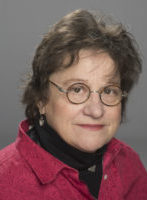Public School Kids Get Assembly on Sex Changes
By Cathy Ruse, FRC’s Senior Fellow for Legal Studies

Amy Ellis Nutt
A Northern Virginia public school held a school-wide assembly before Christmas break featuring transgender crusader Amy Ellis Nutt. George Mason High School in the City of Falls Church brought in Nutt, a Washington Post reporter, to lecture students on her book Becoming Nicole, about a boy who “identified” as a girl as a toddler, had his puberty suppressed as a child, and was castrated as a teenager.
Nutt’s lecture hit all the usual notes. Your gender is “assigned at birth” by people who might get it wrong. Toddlers can be transgender. Moray eels change sex and female reef fish produce sperm when there are no males. “Gender is a spectrum,” everyone must get “comfortable” with new gender language that is “changing every day.” Asking a biological boy to use the teachers’ rather than the girls’ restroom is “bullying.”
The full assembly can be viewed on YouTube:
The sponsor of the event was the Falls Church Education Foundation.
Did the school make plain to the students that they could decline to attend? That’s not clear. In her presentation, Nutt quipped: “Thank you for coming, although I know you’re probably required to be here.”
Nor is it clear whether parents were fully informed about the assembly in advance. At least one shocked George Mason teacher, who remains anonymous, says parents were not.
What does seem clear is that this public school will not hold another school-wide assembly featuring other views on the issue: such as first-person accounts of the negative consequences of “transitioning,” health warnings from pediatricians and other medical experts, or condemnation from the feminist community, from which the term “female erasure” has sprung to describe the transgender program.
Transgender ideology in children is extremely controversial, not least because so many children who experience gender dysphoria later desist and accept their natal biology. According to the Diagnostic and Statistical Manual of Mental Disorders, 5th edition (DSM-5) as many as 98% of boys and 88% of girls will “grow out of” their gender dysphoria and accept their biological sex after naturally passing through puberty.
There is no medical or psychological test to show which 2% of those boys will persist in their gender dysphoria as young adults. Protocols that encourage school-wide affirmation of every case of gender dysphoria could impede the overwhelming majority of children from accepting their natal biology, as well as sow confusion in other vulnerable children.
There has been a spate of articles in recent weeks on the phenomenon of “rapid onset” gender dysphoria in teen girls, thought to be a “social contagion” like anorexia 30 years ago. Details of these cases reported by therapists are heartbreaking.
At the end of the talk, Nutt was asked two student questions, written on index cards.
“What is gender dysphoria and how does the transgender community respond to the idea that they are glorifying the mental health condition known as gender dysphoria?”
That was a good question, and evidence that at least one student at George Mason has held on to his critical thinking skills.
Nutt’s answer was not good: “Gender dysphoria is not a mental health condition,” she said, continuing:
It is included in the DSM, which is the bible of mental illnesses, of psychiatrists, but only because gender dysphoria isn’t the inability or confusion of a transgender child to understand why they are the way they are, it’s the failure for [sic] other people to understand that. It’s the confusion that comes because of the cultural misconceptions and not being able to fit into that.
So a person is diagnosed because other people are confused? It’s in “the bible of mental illnesses” because it’s a healthy condition that the culture doesn’t understand? Now I am confused.
The DSM defines gender dysphoria in children as “clinically significant distress” from “a marked incongruence between one’s experienced/expressed gender and assigned gender” manifested by, among other things, “a strong dislike of one’s sexual anatomy.”
The ICD – the International Classification of Diseases – calls it a “childhood disorder” characterized by “persistent and intense distress.” Diagnosis requires “a profound disturbance of the normal gender identity.”
If Nutt is trying to dismiss their distress as a cultural condition, she’s freelancing.
The final question was also a good one: “Did Nicole undergo reassignment surgery and if so was there any risk to it?”
Nutt’s answer was bad, and sort of creepy. “Yes. She was 17 at the time…I was there.”
“It was not the most important thing…but it was the last thing that she needed to do,” said Nutt.
“What was important for her early on was to have her puberty suppressed as a child, so that she knew what she really wanted.”
Puberty-blockers are serious business. Puberty suppression and cross-sex hormones can stunt a person’s growth and render him completely infertile, never able to have genetically-related children, even by artificial means. You cannot walk back up this road.
What’s more, there are no scientific studies on their use by growing children. None.
Nutt’s cavalier treatment of puberty blockers was awfully reckless.
And isn’t her logic backwards? How does blocking your natural development tell you what you really want? Isn’t it, rather, tipping the scales toward an ideologically pre-determined outcome?
Did Nicole even have the capacity to consent to this untested, irreversible medical treatment in the first place? “There is a serious ethical problem with allowing irreversible, life-changing procedures to be performed on minors who are too young to give valid consent themselves,” cautions the American College of Pediatricians.
Nutt went on: “When the time for puberty came, she took estrogen, and she made the puberty that all girls do at the right time.”
Making the puberty that all girls do is strange phraseology. But of course this teen could not make the puberty that all girls do without ovaries and a uterus. Were the teen girls in the audience misled? Were the boys?
As to risk, Nutt brushed it aside: “You know, there’s always a risk to surgery, it’s actually not that complicated.”
“She will be, for all purposes, physically and biologically a girl. A woman.”
Wrong. Biologically, Nicole will never be a girl. Every cell in Nicole’s body contains male sex chromosomes. A lifetime of male-suppressing hormones will never change that fact.
At one point in her lecture, Nutt said: “I’m not trying to be funny, I’m trying to be factual.”
She should have tried harder.
Children suffering from gender dysphoria deserve our compassion. Surely their suffering is genuine, and profound. But they also deserve an adult response: first and foremost, our recognition that the distress and confusion they are experiencing will give way to acceptance of their natal biology in the vast majority of cases.
The person with persistent dysphoria who ultimately chooses radical surgery and a lifetime of hormones deserves compassion, too. As well as great sympathy, in my opinion, for treating a healthy body as sick and a troubled mind as healthy.
Nutt obviously disagrees. There is great disagreement on this issue, especially among medical experts.
When a public school takes sides, nobody wins. But students, and taxpayers, lose.
Tony Perkins’ Washington Update is written with the aid of FRC senior writers.
RELATED ARTICLE: What You Can Do to Fight Sex Trafficking



Leave a Reply
Want to join the discussion?Feel free to contribute!